Motorola Mobility T56AS1 Portable Cellular Transceiver User Manual UPDATED Exhibit 8 Users Manual RESPONSE TO 17976 1of 2
Motorola Mobility LLC Portable Cellular Transceiver UPDATED Exhibit 8 Users Manual RESPONSE TO 17976 1of 2
Contents
- 1. Exhibit 8 Users Manual
- 2. UPDATED Exhibit 8 Users Manual RESPONSE TO 17976 1of 2
- 3. UPDATED Exhibit 8 Users Manual 2 of 2
- 4. Exhibit 8C Updated Users Manual RESPONSE TO 18898
UPDATED Exhibit 8 Users Manual RESPONSE TO 17976 1of 2

APPLICANT: MOTOROLA, INC. FCC ID: IHDT56AS1
EXHIBIT 8A
INSTRUCTION MANUAL
A preliminary draft copy of the Users Manual follows:
Note:
Correspondence Reference Number: 17917 requested a change in user
manual text. (FYI - For future filings, please indicate in the users manual
"the phone and its antenna" instead of "the antenna" for instructions that
require users to maintain a separation distance.)
The next two pages contains the text which will be incorporated into the
final version of the manual.

15
Safety and General Information
Portable Phone Operation and EME
Exposure
Antenna Care
Use only the supplied or an approved replacement
antenna.
Unauthorized antennas, modifications, or
attachments could damage the phone and may violate FCC
regulations.
Do NOT hold the antenna when the phone is in use.
Holding the antenna affects call quality and may cause the
phone to operate at a higher power level than needed.
Phone Operation
When placing or receiving a phone call, hold your phone as you
would a wireline telephone.
Speak directly into the
microphone.
Body-Worn Operation
To maintain compliance with FCC RF exposure guidelines, if you
wear a phone on your body when transmitting, always place the
phone in a
Motorola-supplied or approved clip, holder,
holster, case, or body harness.
Use of
non-Motorola-approved accessories may exceed FCC RF
exposure guidelines.
If you do not use a body-worn
accessory, and are not holding the phone in the normal
use position at the ear, ensure the phone and its
antenna are at least one inch (2.5 centimeters) from
your body when transmitting.

Safety and General Information
16
Data Operation
When using any data feature of the phone, with or without an
accessory cable,
position the phone and its antenna at
least one inch (2.5 centimeters) from your body.
Approved Accessories
For a list of approved Motorola accessories, visit our website at
www.motorola.com.
Electromagnetic Interference/
Compatibility
Note:
Nearly every electronic device is susceptible to
electromagnetic interference (EMI) if inadequately shielded,
designed, or otherwise configured for electromagnetic
compatibility.
Facilities
To avoid electromagnetic interference and/or compatibility
conflicts, turn off your phone in any facility where posted notices
instruct you to do so. Hospitals or health care facilities may be
using equipment that is sensitive to external RF energy.
Aircraft
When instructed to do so, turn off your phone when on board an
aircraft. Any use of a phone must be in accordance with
applicable regulations per airline crew instructions.
Phoenix TDMA
Wireless Telephone
Basic User’s Guide
Draft
December 21, 2000
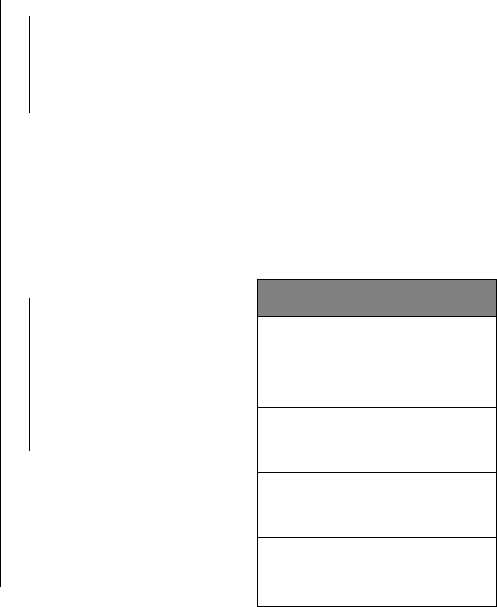
Menu Map
Main Menu
• Recent Calls
• Received Calls
• Dialed Calls
• Notepad
• Call Times
• Phonebook
• Datebook
• Quick Dial
• Radio
• Messages
• Voicemail
• Text Msgs
• Browser Alerts
• Quick Notes
• Outbox
• Drafts
• Shortcuts
• Voice Notes
• Browser
• Settings
(see reverse)
N
ote:
Thi
s
i
s t
h
e stan
d
ar
d
menu
layout. You or your service
provider may have modified the
menu structure or changed some
feature names. Not all features
may be available for all users. For
example, the
Radio
feature is
displayed only when the FM
radio headset accessory is
plugged into the accessory
connector port on your phone.
Shortcuts
Change display zoom:
Press
M
, then
press and hold
M
Lock/unlock keypad:
Press
M
*
Display my phone number:
Press
M
#
Go to dialed calls list:
Press
N

Settings Menu
• Ring/Vibrate
• Alert
•
Alert
Detail
• Phone Status
• My Tel. Number
• Battery Meter
• Other Information
• Connection
• Incoming Call
• In-Call Setup
• In-Call Timer
• Answer Options
• Security
• Phone Lock
• Lock Keypad
• Lock Application
• Restrict Calls
• New Passwords
• Other Settings
• Personalize
• Main Menu
• Keys
• Greeting
• Banner
• Quick Dial
• Initial Setup
• Time and Date
• Auto PIN Dial
• Auto Redial
• Backlight
• Status Light
• Zoom
• Scroll
• Animation
• Language
• Battery Save
• Contrast Setting
• DTMF
• Master Reset
• Master Clear
• Network
• Car Settings
• Headset
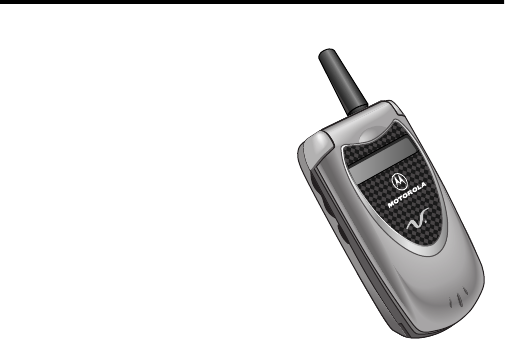
1
Welcome
Welcome to the world of
Motorola digital wireless
communications!
Motorola is a global
leader in
communications
technology. We are
pleased that you have
chosen the Motorola
V
Series 60t
wireless phone to keep
you connected with
ease.
All Motorola phones are designed and manufactured to
meet Motorola’s rigorous specifications and world-class
quality standards. During development, our testing
team took the Motorola
V
through rigorous
durability tests including temperature, humidity, shock,
dust, vibration, and drop tests.
We are confident that you and your callers will find your
wireless phone to be a convenient and reliable way to
stay in touch. Thank you for choosing Motorola
V
,
and enjoy your new phone!
2
Personal Communications Sector
600 North U.S. Highway 45
Libertyville, Illinois 60048
1-800-331-6456 (United States)
1-888-390-6456 (TTY/TDD United States)
1-800-461-4575 (Canada)
www.motorola.com
MOTOROLA, the Stylized M Logo and all other
trademarks indicated as such herein are trademarks of
Motorola, Inc. ® Reg. U.S. Pat. & Tm. Off. TrueSync is a
trademark of Starfish, Inc., a wholly owned independent
subsidiary of Motorola, Inc. All other product or service
names are the property of their respective owners.
© 2000 Motorola, Inc. All rights reserved. Printed in the
U.S.A.
Manual number: 6809435A45-O
Cover number: 8988485L07
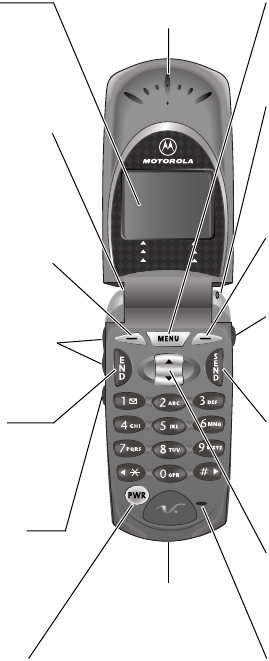
3
Phone Diagram
Earpiece
Headset Jack
Insert headset
accessory for
hands-free use.
Status Light
See incoming call
and service status.
Volume Keys
Adjust earpiece
and ringer volume.
Smart Key
Select menu
items, send and
end calls.
Voice Key
Record voice notes,
phonebook and
shortcut names.
Display
Microphone
Accessory
Connector Port
Insert charger and
phone accessories.
Power Key
Right Soft Key
Perform functions
identified by right
display prompt.
Menu Key
End Key
End phone calls,
exit menu system.
Scroll Key
Move through
menus and lists.
Left Soft Key
Perform functions
identified by left
display prompt.
Send Key
Send and answer
calls, view recent
dialed calls list.

4
Contents
Phone Diagram
. . . . . . . . . . . . . . . . . . . . . . . . . . . 3
About This Guide
. . . . . . . . . . . . . . . . . . . . . . . . . 10
Safety and General Information
. . . . . . . . . . . . 12
Getting Started
. . . . . . . . . . . . . . . . . . . . . . . . . . 21
What’s in the Box? . . . . . . . . . . . . . . . . . . . . . . . 21
Installing the Battery . . . . . . . . . . . . . . . . . . . . . . 22
Charging the Battery . . . . . . . . . . . . . . . . . . . . . . 24
Turning Your Phone On . . . . . . . . . . . . . . . . . . . . 25
Sending a Call . . . . . . . . . . . . . . . . . . . . . . . . . . . 26
Ending a Call . . . . . . . . . . . . . . . . . . . . . . . . . . . . 27
Receiving a Call . . . . . . . . . . . . . . . . . . . . . . . . . . 27
Displaying Your Phone Number . . . . . . . . . . . . . . 27
About Your Phone
. . . . . . . . . . . . . . . . . . . . . . . . 28
Display . . . . . . . . . . . . . . . . . . . . . . . . . . . . . . . . 28
Changing the Zoom Setting . . . . . . . . . . . . . . . . . 31
Status Light . . . . . . . . . . . . . . . . . . . . . . . . . . . . . 32
Volume Keys . . . . . . . . . . . . . . . . . . . . . . . . . . . . 33
Smart Key . . . . . . . . . . . . . . . . . . . . . . . . . . . . . . 34
External Display . . . . . . . . . . . . . . . . . . . . . . . . . . 35
Battery Use . . . . . . . . . . . . . . . . . . . . . . . . . . . . . 36

5
Contents
Sending and Receiving Calls
. . . . . . . . . . . . . . . 38
Redialing a Number . . . . . . . . . . . . . . . . . . . . . . 38
Using Automatic Redial . . . . . . . . . . . . . . . . . . . . 38
Caller ID . . . . . . . . . . . . . . . . . . . . . . . . . . . . . . . 39
Returning an Unanswered Call . . . . . . . . . . . . . . 39
Dialing an Emergency Number When the Phone is
Locked . . . . . . . . . . . . . . . . . . . . . . . . . . . . . . . . 40
Entering Numbers in the Notepad . . . . . . . . . . . . 41
Muting the Ring or Vibrate Alert . . . . . . . . . . . . . 41
Terminating an Incoming Call . . . . . . . . . . . . . . . 42
Dialing With Speed Dial . . . . . . . . . . . . . . . . . . . 42
Dialing With One-Touch Dial . . . . . . . . . . . . . . . . 43
Dialing a Number In a Text Message . . . . . . . . . . 44
Additional Dialing Features . . . . . . . . . . . . . . . . . 45
Using Features While On a Call
. . . . . . . . . . . . . 47
Using Call Waiting . . . . . . . . . . . . . . . . . . . . . . . 47
Making a Three-Way Call . . . . . . . . . . . . . . . . . . 48
Additional On-Call Features . . . . . . . . . . . . . . . . 48
Using the Menu
. . . . . . . . . . . . . . . . . . . . . . . . . . 50
Navigating to a Feature . . . . . . . . . . . . . . . . . . . 50
Selecting a Feature Option . . . . . . . . . . . . . . . . . 51
Entering Feature Information . . . . . . . . . . . . . . . . 52
Entering Text . . . . . . . . . . . . . . . . . . . . . . . . . . . 54

Contents
6
Menu Feature Descriptions
. . . . . . . . . . . . . . . . 62
Recent Calls
. . . . . . . . . . . . . . . . . . . . . . . . . . . . . 75
Viewing the Received Calls or Dialed Calls List . . . 75
Using the Notepad . . . . . . . . . . . . . . . . . . . . . . . . 78
Call Times . . . . . . . . . . . . . . . . . . . . . . . . . . . . . . 79
Viewing and Resetting Call Times . . . . . . . . . . . . . 80
Phonebook
. . . . . . . . . . . . . . . . . . . . . . . . . . . . . . 81
Fields in a Phonebook Entry Form . . . . . . . . . . . . . 81
Storing a Phonebook Entry . . . . . . . . . . . . . . . . . . 82
Recording a Voice Name For a Phonebook Entry . . 85
Dialing a Phonebook Entry . . . . . . . . . . . . . . . . . . 87
Editing a Phonebook Entry . . . . . . . . . . . . . . . . . . 88
Deleting a Phonebook Entry . . . . . . . . . . . . . . . . . 89
Checking Phonebook Capacity . . . . . . . . . . . . . . . 90
Synchronizing with TrueSync Software . . . . . . . . . 90
Setting Up the Phonebook . . . . . . . . . . . . . . . . . . 91
Datebook
. . . . . . . . . . . . . . . . . . . . . . . . . . . . . . . 92
Week View . . . . . . . . . . . . . . . . . . . . . . . . . . . . . 92
Day View . . . . . . . . . . . . . . . . . . . . . . . . . . . . . . . 93
Event View . . . . . . . . . . . . . . . . . . . . . . . . . . . . . 94
Storing a New Event . . . . . . . . . . . . . . . . . . . . . . 95
Changing Event Information . . . . . . . . . . . . . . . . 96
Copying an Event . . . . . . . . . . . . . . . . . . . . . . . . . 97
Deleting an Event . . . . . . . . . . . . . . . . . . . . . . . . 98

7
Contents
Radio
. . . . . . . . . . . . . . . . . . . . . . . . . . . . . . . . . . 99
Turning the Radio On and Off . . . . . . . . . . . . . . . 99
Tuning a Station . . . . . . . . . . . . . . . . . . . . . . . . 100
Storing a Preset . . . . . . . . . . . . . . . . . . . . . . . . 100
Selecting a Preset . . . . . . . . . . . . . . . . . . . . . . . 100
Sending and Receiving Calls with the Radio On . 101
Messages—Voicemail
. . . . . . . . . . . . . . . . . . . 102
Storing Your Voicemail Number . . . . . . . . . . . . . 102
Receiving a New Voicemail Message . . . . . . . . . 102
Listening to a Voicemail Message . . . . . . . . . . . 103
Messages—Text
. . . . . . . . . . . . . . . . . . . . . . . . 104
Setting Up the Text Message Inbox . . . . . . . . . . 104
Receiving a New Text Message . . . . . . . . . . . . . 106
Reading, Locking, or Deleting a Text Message . . 106
Sending a New Text Message . . . . . . . . . . . . . . 109
Viewing the Status of Sent Text Messages . . . . . 110
Shortcuts
. . . . . . . . . . . . . . . . . . . . . . . . . . . . . . 111
Standard Shortcuts . . . . . . . . . . . . . . . . . . . . . . 111
User-Settable Shortcuts . . . . . . . . . . . . . . . . . . . 112
Creating a Shortcut . . . . . . . . . . . . . . . . . . . . . . 112
Using Shortcuts . . . . . . . . . . . . . . . . . . . . . . . . 115
Voice Notes
. . . . . . . . . . . . . . . . . . . . . . . . . . . . 117
Recording a Voice Note . . . . . . . . . . . . . . . . . . . 117
Viewing the Voice Notes List . . . . . . . . . . . . . . . 119

Contents
8
Playing a Voice Note . . . . . . . . . . . . . . . . . . . . . 120
Locking and Unlocking a Voice Note . . . . . . . . . . 123
Deleting a Voice Note . . . . . . . . . . . . . . . . . . . . 124
Micro-Browser
. . . . . . . . . . . . . . . . . . . . . . . . . . 125
Starting a Micro-Browser Session . . . . . . . . . . . . 125
Interacting With Web Pages . . . . . . . . . . . . . . . . 126
Adjusting Your Settings
. . . . . . . . . . . . . . . . . . 127
Ring/Vibrate . . . . . . . . . . . . . . . . . . . . . . . . . . . 127
Reminders . . . . . . . . . . . . . . . . . . . . . . . . . . . . . 129
Reordering Menu Items . . . . . . . . . . . . . . . . . . . 130
Customizing a Soft Key Function . . . . . . . . . . . . 131
Hands-Free Use . . . . . . . . . . . . . . . . . . . . . . . . . 131
Data and Fax Calls
. . . . . . . . . . . . . . . . . . . . . . . 135
Connecting Your Phone to an External Device . . . 135
Sending a Data or Fax Call . . . . . . . . . . . . . . . . . 138
Receiving a Data or Fax Call . . . . . . . . . . . . . . . . 139
Security
. . . . . . . . . . . . . . . . . . . . . . . . . . . . . . . . 143
Assigning a New Code or Password . . . . . . . . . . 143
If You Forget a Code or Password . . . . . . . . . . . . 145
Locking and Unlocking Your Phone . . . . . . . . . . . 145
Locking and Unlocking Your Keypad . . . . . . . . . . 147
Restricting Calls . . . . . . . . . . . . . . . . . . . . . . . . . 148

9
Contents
Troubleshooting
. . . . . . . . . . . . . . . . . . . . . . . . 150
Programming Instructions
. . . . . . . . . . . . . . . . 161
Specific Absorption Rate Data
. . . . . . . . . . . . 163
FDA Update
. . . . . . . . . . . . . . . . . . . . . . . . . . . . 166
Warranty
. . . . . . . . . . . . . . . . . . . . . . . . . . . . . . 178
Patent Information
. . . . . . . . . . . . . . . . . . . . . . 188
Export Law Assurances
. . . . . . . . . . . . . . . . . . 195
Index
. . . . . . . . . . . . . . . . . . . . . . . . . . . . . . . . . 196

10
About This Guide
Using Your Phone’s Features
This user guide introduces you to the many features in
your Motorola
V
phone. A reference guide for your
phone is also available which explains the phone’s
features in more detail. To obtain a copy of the
reference guide or another copy of this user guide, see
the Motorola Web site at:
http://motorola.com/consumer/manuals
or contact the Motorola Customer Call Center at
1-800-331-6456.
Navigating to a Menu Feature
You can access many of your phone’s features through
the menu system. This guide shows you how to navigate
to a specific menu feature as follows:
The > symbol means that you should scroll to and select
the feature. This example shows that you must press
M
, scroll to and select
Recent Calls
, then scroll to
and select
Dialed Calls to view the dialed calls list.
Find the Feature
M> Recent Calls
> Dialed Calls

11
About This Guide
Optional Features
Features marked with this label are optional
network and subscription-dependent features.
Contact your service provider for information
about availability.
Optional Accessories
Features marked with this label require the use
of an optional Motorola Original™ accessory.

12
Safety and General
Information
IMPORTANT INFORMATION ON SAFE AND EFFICIENT
OPERATION. READ THIS INFORMATION BEFORE USING
YOUR PHONE.
RF Operational Characteristics
Your phone contains a transmitter and a receiver. When
it is ON, it receives and transmits radio frequency (RF)
energy. The phone operates in the frequency range of .
When you communicate with your phone, the system
handling your call controls the power levels at which
your phone transmits. The output power level typically
may vary over a range from watts to watts in analog
mode and watts to watts in digital mode.
Exposure To Radio Frequency Energy
Your Motorola phone is designed to comply with the
following national and international standards and
guidelines regarding exposure of human beings to radio
frequency electromagnetic energy (EME):
• United States Federal Communications
Commission, Code of Regulations; 47 CFR part 2
sub-part J

13
Safety and General Information
• American National Standards Institute (ANSI) /
Institute of Electrical and Electronic Engineers (IEEE)
C95. 1-1992
• Institute of Electrical and Electronic Engineers (IEEE)
C95.1-1999 Edition
• National Council on Radiation Protection and
Measurements (NCRP) of the United States, Report
86, 1986
• International Commission on Non-Ionizing
Radiation Protection (ICNIRP) 1998
• National Radiological Protection Board of the
United Kingdom 1995
• Ministry of Health (Canada) Safety Code 6. Limits of
Human Exposure to Radiofrequency
Electromagnetic Fields in the Frequency Range from
3 kHz to 300 GHz, 1999
• Australian Communications Authority
Radiocommunications (Electromagnetic
Radiation-Human Exposure) Standard 1999
To assure optimal phone performance and make sure
human exposure to radio frequency electromagnetic
energy is within the guidelines set forth in the above
standards, always adhere to the following procedures:

Safety and General Information
14
Portable Phone Operation and EME
Exposure
Antenna Care
Use only the supplied or an approved
replacement antenna. Unauthorized antennas,
modifications, or attachments could damage the phone
and may violate FCC regulations.
Do NOT hold the antenna when the phone is in
use. Holding the antenna affects call quality and may
cause the phone to operate at a higher power level than
needed.
Phone Operation
When placing or receiving a phone call, hold your
phone as you would a wireline telephone. Speak
directly into the microphone.
Body-Worn Operation
To maintain compliance with FCC RF exposure
guidelines, if you wear a phone on your body when
transmitting, always place the phone in a
Motorola-supplied or approved clip, holder,
holster, case, or body harness. Use of
non-Motorola-approved accessories may exceed FCC RF

15
Safety and General Information
exposure guidelines. If you do not use a body-worn
accessory, and are not holding the phone in the
normal use position at the ear, ensure the
antenna is at least one inch (2.5 centimeters)
from your body when transmitting.
Data Operation
When using any data feature of the phone, with or
without an accessory cable, position the phone
antenna at least one inch (2.5 centimeters) from
your body.
Approved Accessories
For a list of approved Motorola accessories, visit our
website at www.motorola.com.
Electromagnetic Interference/
Compatibility
Note: Nearly every electronic device is susceptible to
electromagnetic interference (EMI) if inadequately
shielded, designed, or otherwise configured for
electromagnetic compatibility.

Safety and General Information
16
Facilities
To avoid electromagnetic interference and/or
compatibility conflicts, turn off your phone in any facility
where posted notices instruct you to do so. Hospitals or
health care facilities may be using equipment that is
sensitive to external RF energy.
Aircraft
When instructed to do so, turn off your phone when on
board an aircraft. Any use of a phone must be in
accordance with applicable regulations per airline crew
instructions.
Medical Devices
Pacemakers
The Health Industry Manufacturers Association
recommends that a minimum separation of 6 inches
(15 centimeters) be maintained between a handheld
wireless phone and a pacemaker. These
recommendations are consistent with the independent
research by, and recommendations of, Wireless
Technology Research.
Persons with pacemakers should:

17
Safety and General Information
• ALWAYS keep the phone more than six inches
(15 centimeters) from your pacemaker when the
phone is turned ON.
• NOT carry the phone in the breast pocket.
• use the ear opposite the pacemaker to minimize the
potential for interference.
• turn OFF the phone immediately if you have any
reason to suspect that interference is taking place.
Hearing Aids
Some digital wireless phones may interfere with some
hearing aids. In the event of such interference, you may
want to consult your hearing aid manufacturer to
discuss alternatives.
Other Medical Devices
If you use any other personal medical device, consult
the manufacturer of your device to determine if it is
adequately shielded from RF energy. Your physician may
be able to assist you in obtaining this information.

Safety and General Information
18
Safety and General
Use While Driving
Check the laws and regulations on the use of phones in
the area where you drive. Always obey them.
When using your phone while driving, please:
• give full attention to driving and to the road.
• use hands-free operation, if available.
• pull off the road and park before making or
answering a call if driving conditions so require.
Operational Warnings
For Vehicles With an Air Bag
Do not place a portable phone in the area over an air
bag or in the air bag deployment area. An air bag
inflates with great force. If a portable phone is placed in
the air bag deployment area and the air bag inflates,
the phone may be propelled with great force and cause
serious injury to the vehicle’s occupants.

19
Safety and General Information
Potentially Explosive Atmospheres
Turn off your phone prior to entering any area with a
potentially explosive atmosphere, unless the phone is a
model specifically identified as being “Intrinsically Safe”
for use in such areas (for example, Factory Mutual, CSA,
or UL Approved). Do not remove, install, or charge
batteries in such areas. Sparks in a potentially explosive
atmosphere can cause an explosion or fire resulting in
bodily injury or even death.
Note: Areas with potentially explosive atmospheres
include fueling areas such as below decks on boats, fuel
or chemical transfer or storage facilities, areas where
the air contains chemicals or particles such as grain,
dust, or metal powders, and any other area where you
would normally be advised to turn off your vehicle
engine. Areas with potentially explosive atmospheres
are often but not always posted.
Blasting Caps and Areas
To avoid possible interference with blasting operations,
turn OFF your phone when you are near electrical
blasting caps, in a blasting area, or in areas posted:
“Turn off two-way radio.” Obey all signs and
instructions.

Safety and General Information
20
Operational Cautions
Antennas
Do not use any portable phone that has a
damaged antenna. If a damaged antenna comes into
contact with your skin, a minor burn can result.
Batteries
All batteries can cause property damage and/or bodily
injury such as burns if a conductive material such as
jewelry, keys, or beaded chains touches exposed
terminals. The conductive material may complete an
electrical circuit (short circuit) and become quite hot.
Exercise care in handling any charged battery,
particularly when placing it inside a pocket, purse, or
other container with metal objects.
GEN080900
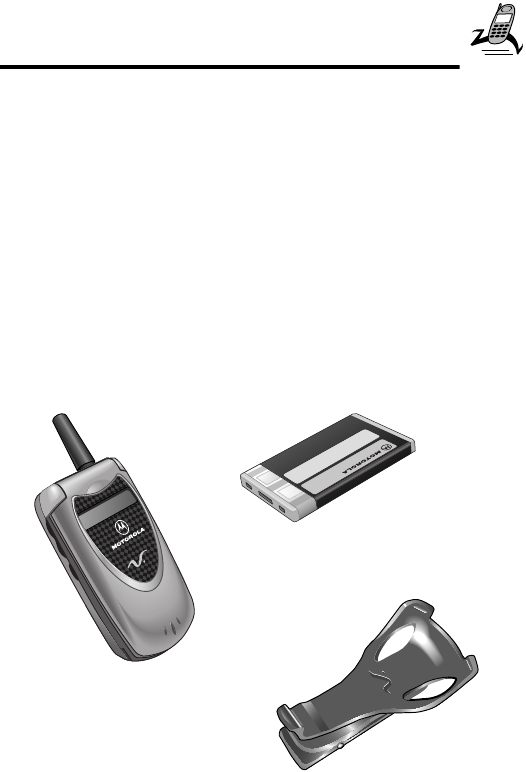
21
Getting Started
What’s in the Box?
Your digital wireless phone typically comes equipped
with a battery and a charger. Other accessory options
can customize your phone for maximum performance
and portability. The following illustrations show a
sample of the package contents.
Note: Your phone and accessories may not look exactly
as pictured.
Motorola
Telephone
Battery
Holster
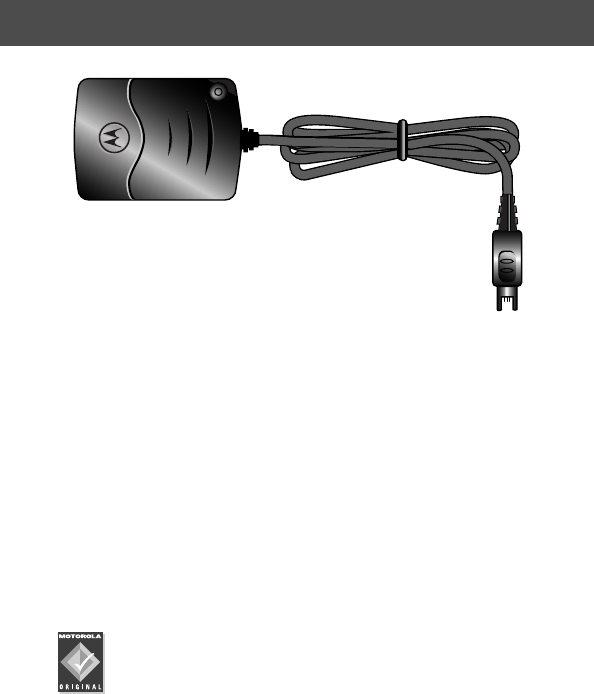
Getting Started
22
To purchase Motorola Original™ accessories, please
phone 1-800-331-6456 in the United States or
1-800-461-4575 in Canada.
Installing the Battery
Before you can use your phone, you need to install and
charge the battery.
Your phone is designed to be used only with
Motorola Original batteries and accessories. We
recommend that you store batteries in their
protective cases when not in use.
Travel Charger
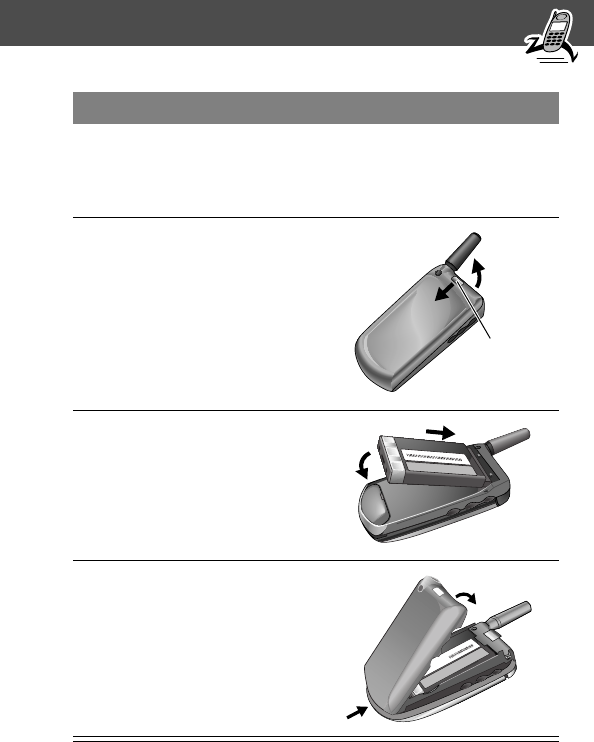
23
Getting Started
Do This
1
Remove the battery
from its protective clear
plastic case.
2
If the phone’s battery
door is already in place,
push down the battery
door release latch and
lift the battery door off
of the phone.
3
Insert the battery,
printed arrows first, into
the battery
compartment and push
down.
4
Insert the ridge at the
bottom of the battery
door into the base of
the phone, then push
the door down and
snap it into place.
Release
latch
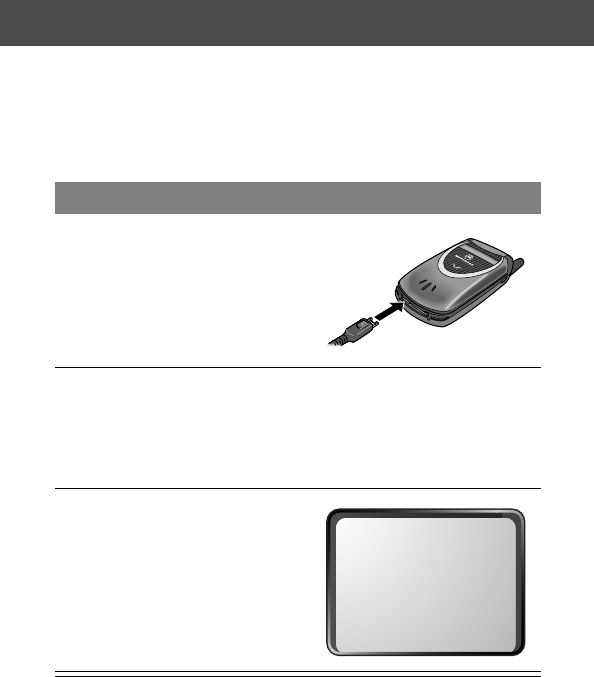
Getting Started
24
Charging the Battery
Before you can use your phone, you need to install and
charge the battery.
Tip: When your phone is turned on, the battery level
indicator in the upper right corner of the phone display
shows the amount of charge left in your battery. (See
the “Battery Level Indicator” item on page 30.)
Do This
1
Plug the travel charger
into your phone with
the release tab facing
up.
2
Plug the other end of
the travel charger into
the appropriate
electrical outlet.
3
When your phone
indicates that the
battery is fully charged,
press the release tab
and remove the travel
charger.
Charge Complete
PH BOOK MESSAGE
M
5E
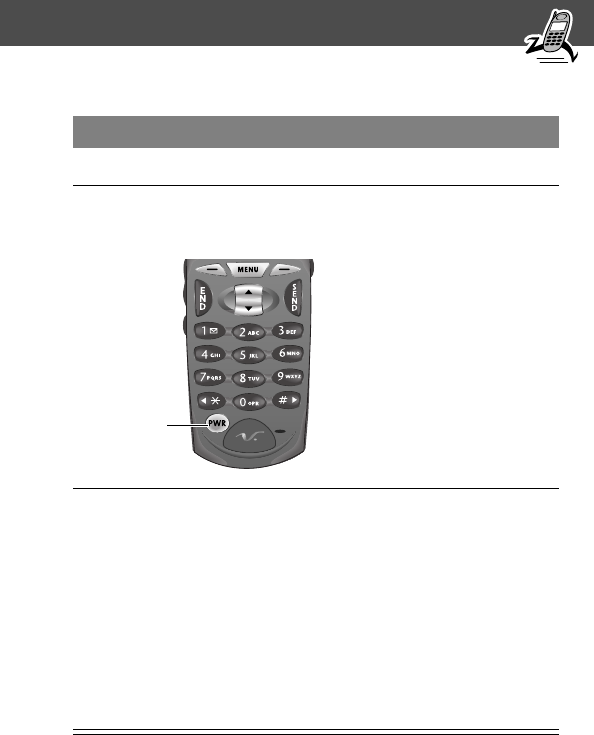
25
Getting Started
Turning Your Phone On
Do This To
1
Open your phone expose the keypad
2
Press and hold P
(the power key)
turn on your phone
3
Enter your four-digit
unlock code and press
OK (+)
unlock your phone, if
necessary
The unlock code is
originally set to 1234.
(For more information,
see “Locking and
Unlocking Your Phone”
on page 145.)
Power
key

Getting Started
26
Sending a Call
To call a number, your phone must be turned on, be
unlocked, and have a network connection with
adequate signal strength.
Do This To
1
Extend the
antenna
optimize signal reception
2
Press the
keypad keys
dial the phone number (up to 32
digits)
Tip: If you make a mistake,
press DELETE (-) to delete
the last digit, or press and hold
DELETE (-) to clear all digits.
3
Press N
(send key)
send the call

27
Getting Started
Ending a Call
Receiving a Call
To receive a call, your phone must be turned on and
have a network connection with adequate signal
strength. If your phone is locked, you must unlock the
phone to answer the call.
When you receive a call, your phone rings and/or
vibrates and displays an incoming call message.
Displaying Your Phone Number
From the idle display:
Press To
O (end key) end the call
Press To
N or ANSWER (+)answer the call
Press To
M #see your phone number

28
About Your Phone
See page 3 for a diagram of your phone that describes
basic phone components.
Display
The top section of the display shows phone status
indicators. The following illustration shows some of the
common indicators that you may see at the top of the
display when using your phone.
Messages, phone numbers, and menu options appear in
the middle of the display. Text labels at the bottom
corners of the display show the current soft key
functions. A M (menu) indicator in the bottom center of
the display indicates that you can open the main menu
or a feature sub-menu to see more options. For more
information about the soft key and menu key labels, see
“Using the Menu” on page 50.
Some of the phone functions described in this guide
must be performed from the idle display. The term
idle
display
refers to the standard display that you see when
your phone is on and ready to use, when you are
not
on
a call or using the menu system.
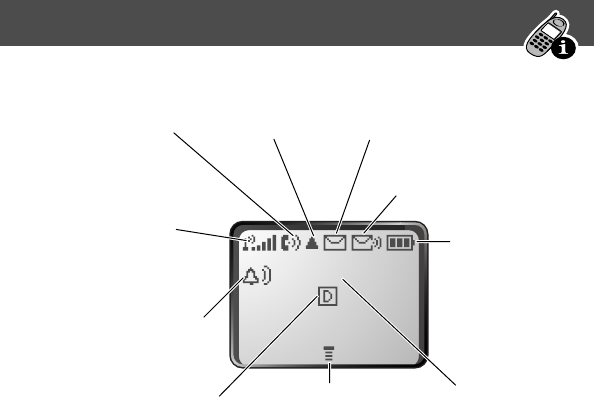
29
About Your Phone
➊ Signal Strength Indicator Shows the strength of
your phone’s connection with the network.
You cannot send or receive calls when the “no signal”
indicator is displayed.
➋ In Use Indicator Appears when a call is in
progress.
➌ Roam Indicator Appears when your phone uses
another network system outside your home network.
Strong 5 4 3 2 1 j No signal
12:00am
➊
Signal
Strength
Indicator
➐
Clock
➏
Battery
Level
Indicator
➒
Digital/Analog
Signal Indicator
➋
In Use
Indicator
➌
Roam
Indicator
➍
Message Waiting
Indicator
➎
Voice Message
Waiting Indicator
➓
Alert Setting
Indicator
➑
Menu Indicator

About Your Phone
30
When you leave your home network area, your phone
roams
or seeks another network.
➍ Message Waiting Indicator Appears
when your phone receives a text message.
➎ Voice Message Waiting Indicator
Appears when you receive a voicemail
message.
➏ Battery Level Indicator Shows the amount of
charge left in your battery. The more segments visible,
the greater the charge.
Recharge your battery as soon as possible when you see
the Low Battery warning message.
➐ Clock Shows the current time.
➑ Menu Indicator Indicates that you can press M
to open a menu. See “Using the Menu” on page 50.
➒ Digital (F) or Analog (I) Signal Indicator
Shows whether you are receiving a digital or analog
signal.
High E D C B Empty

31
About Your Phone
➓ Alert Setting Indicator Shows the current
selected alert. The default alert setting is a ringer.
Changing the Zoom Setting
You can set your phone’s display to show either three
lines or two lines of text plus soft key labels. Three lines
of text display more information, while two lines
increase text size.
To change the display view, press M once, then
press and hold M again within two seconds of the
first press.
You can also adjust the zoom setting from the menu.
See the “Zoom” item on page 68.
w Loud ring x Soft ring
y Vibrate u Ring and vibrate
t Silent
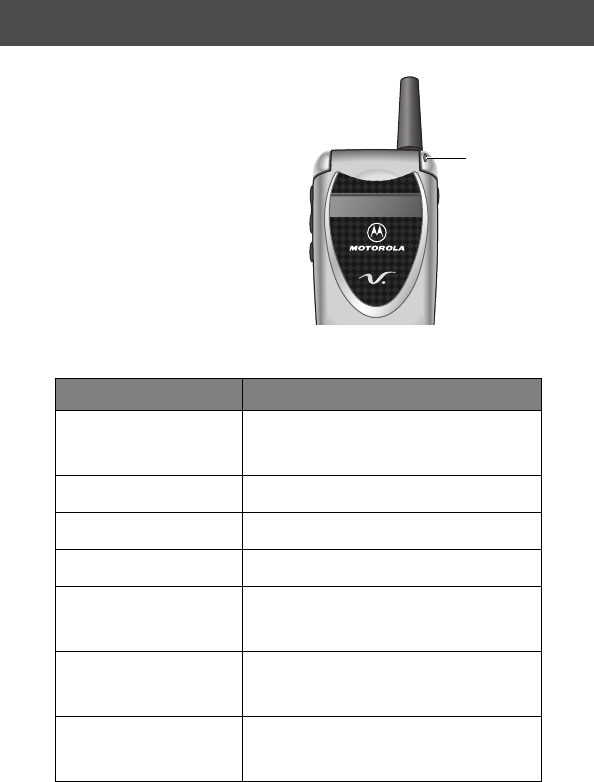
About Your Phone
32
Status Light
The status light tells you
when you have an
incoming call or
message, or when your
phone is
roaming
(using
a non-home system).
The light changes color
to indicate different
states:
Indication State
alternating
red/green (fast)
incoming call
flashing green in service, home system
flashing yellow roaming, non-home system
flashing red (slow) no service
flashing red (fast) text or voicemail message
received, but no service
alternating green
(short)/red (long)
text or voicemail message
received, home service
alternating yellow
(short)/red (long)
text or voicemail message
received, roaming service
Status
light
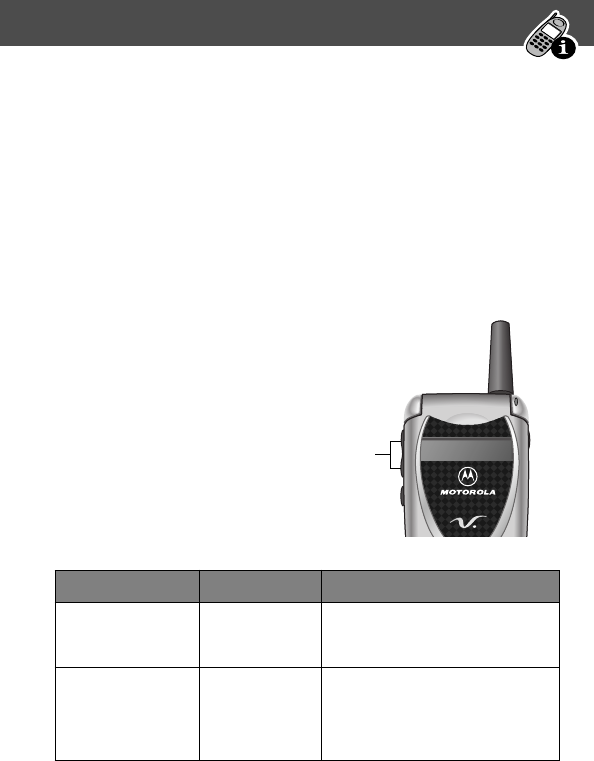
33
About Your Phone
By default, the status light indicator is turned off to
extend battery life. See the “Status Light” item on
page 67 to turn on the status light.
Note: Turning on the status light will substantially
reduce your phone’s
standby time
(the length of time
that your phone’s battery retains power when the
phone is turned on but is not in use).
Volume Keys
Use the upper and
lower volume keys to
adjust your phone’s
earpiece and ringer
volume.
When Press To
During a call volume keys increase or decrease
earpiece speaker volume
From the idle
display (with
flip opened)
volume keys increase or decrease
ringer volume
Volume
keys
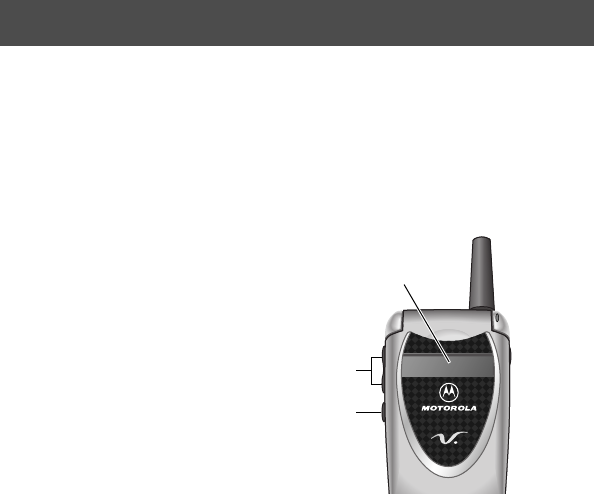
About Your Phone
34
You can also use the volume keys to scroll up or down
through menus and lists.
To change keypad volume, see “Select a Ring/Vibration
for a Specific Event” on page 128.
Smart Key
The smart key gives
you another way to
perform many basic
phone functions. It’s
called the smart key
because it
anticipates the next
action you are likely
to perform. For
example, if you highlight an item and press the smart
key, the smart key selects the highlighted item. You can
use the smart key to send and end calls, select menu
items, toggle features on and off, and open your
phonebook. The smart key usually performs the same
function as the right soft key (+).
You can also use the smart key to perform specific
functions in the external display when the flip is closed.
See the following section for details.
External
display
Volume
keys
Smart
key

35
About Your Phone
External Display
When your phone is on and the flip is closed, the
external display shows the time and date. It also
displays messages to notify you of events (like incoming
calls) that need your attention.
Set Phone Alert
To change your phone’s alert in the external display:
Return an Unanswered Call
When you cannot answer a call, your phone keeps a
record of your unanswered calls and displays the
message X Missed Calls, where X is the total number
of missed calls. When you see the X Missed Calls
message in the external display:
Press To
1
volume keys scroll to Alert
2
smart key select an alert type
3
volume keys return to the idle display
Press To
1
smart key see the received calls list

About Your Phone
36
Note: Because the microphone and earpiece are
unavailable when the phone is closed, you must use a
headset or other hands-free device with this feature.
Battery Use
Caution: To prevent injuries or burns, do not allow
metal objects to contact or short-circuit the battery
terminals.
To maximize your battery’s performance:
• Always use Motorola approved batteries and
battery chargers. The phone warranty does not
cover damage caused from using non-Motorola
batteries and/or battery chargers.
• New batteries or batteries that have been stored for
long periods of time may require a longer charge
time.
• Maintain the battery at or near room temperature
when charging.
2
volume keys scroll through the list and select
a call that you want to return
3
smart key send the call
Press To

37
About Your Phone
• Do not expose batteries to temperatures below -
10°C (14°F) or above 45°C (113°F). Always take
your phone with you when you leave your vehicle.
• When you do not intend to use a battery for a
while, store it uncharged in a cool, dark, dry place,
such as a refrigerator.
• Over extended periods of time, batteries gradually
wear down and require longer charging times. This
is normal. If you charge your battery regularly and
notice a decrease in talk time or an increase in
charging time, then it is probably time to purchase
a new battery.
• The more you talk on the phone or use phone
features (like sending text messages), the less
standby time your battery has. You can also extend
battery life by turning off the status light. (See the
“Status Light” item on page 67.)
The rechargeable batteries that power this
product must be disposed of properly and may
need to be recycled. Refer to your battery’s
label for battery type. Contact your local recycling center
for proper disposal methods. Never dispose of batteries
in a fire because they may explode.

38
Sending and Receiving Calls
For basic instructions on how to send a call, end a call,
and receive a call, see page 26 of the “Getting Started”
section.
Redialing a Number
If you hear an ordinary busy signal, the phone number
you dialed is busy.
Using Automatic Redial
If the network is busy, you hear a fast busy signal, and
your phone displays the message Call Failed.
With automatic redial, your phone repeats the call
attempt over the next four minutes.
Press To
1
O hang up
2
N redial the busy number
Press To
N or RETRY (+)activate automatic redial

39
Sending and Receiving Calls
When the call goes through, your phone rings or
vibrates once, displays Redial Successful, and then
connects the call automatically.
You must activate automatic redial in order to use the
feature. See the “Auto Redial” item on page 66.
Caller ID
The
calling line identification
(caller ID) feature
lets you see who is calling before you answer.
• If the caller’s name is stored in your phonebook, the
phone automatically displays the name. Otherwise,
the phone displays the caller’s phone number.
• If caller ID information is not available, your phone
displays the message Incoming Call.
Returning an Unanswered Call
Your phone keeps a record of your unanswered calls.
When you cannot answer a call, your phone displays:
• the T (missed call) indicator
• the message X Missed Calls Y Unknown, where X
is the total number of missed calls and Y is the

Sending and Receiving Calls
40
number of missed calls for which caller ID
information is not available.
Dialing an Emergency Number When
the Phone is Locked
Your service provider may program one or more
emergency phone numbers that you can call even if
your phone is locked or restricted.
When you see Enter Unlock Code in the display:
Press To
1
VIEW (+) see the received calls list, with
the most recent call at the top
2
S scroll through the list and select
a call that you want to return
3
N send the call
Press To
1
keypad keys dial the emergency number
(such as 911)
2
N call the emergency number

41
Sending and Receiving Calls
Entering Numbers in the Notepad
Your phone stores the most recent string of digits
entered on the keypad in a temporary memory location
called the
notepad
. These digits can be the last phone
number that you called, or a phone number that you
simply entered but did not call. These digits remain in
the notepad even when you turn off the phone.
You can use the notepad to store a phone number that
you intend to call later (such as a phone number told to
you by the other party during a call). To retrieve these
digits, see “Using the Notepad” on page 78.
Muting the Ring or Vibrate Alert
You can mute your phone’s incoming call alert before
answering the call.
While the phone is ringing or vibrating:
To specify a ring or vibration type, see “Ring/Vibrate”
on page 127.
Press To
either volume key turn off the ring or vibration
alert

Sending and Receiving Calls
42
Terminating an Incoming Call
While the phone is ringing or vibrating:
Depending on your phone settings and the type of
subscription you have with your service provider, the call
may be forwarded to another number, or the calling
party may hear a busy signal.
Dialing With Speed Dial
The
speed dial
feature lets you dial any phonebook
entry with a minimal number of keypresses.
Whenever you store an entry in your phonebook, the
entry is assigned a unique speed dial number. If you
know the speed dial number for the phonebook entry
you want to call, you can use the speed dial feature.
Press To
O or IGNORE (-)cancel the incoming call
Press To
1
keypad keys enter the one-, two-, or
three-digit speed dial number
for the entry you want to dial
2
N call the entry

43
Sending and Receiving Calls
To make an entry in the phonebook or view an existing
entry’s speed dial number, see “Storing a Phonebook
Entry” on page 82.
Dialing With One-Touch Dial
You can call phonebook entries 2 through 9 with the
push of a single key. Just press and hold the one-digit
speed dial number for one second.
It is recommended that you reserve location 1 in the
phonebook for storing your voicemail number. In many
cases, your service provider has already stored your
voicemail number in location 1. If your voicemail
number is not accessible by pressing and holding the
1 key:
Do This To
1
Store your voicemail number
in phonebook location
number 1 (see “Storing a
Phonebook Entry” on
page 82)
enable the 1 key
voicemail shortcut
2
Complete the instructions for
“Storing Your Voicemail
Number” on page 102
enable voicemail
soft key and menu
shortcuts

Sending and Receiving Calls
44
To store entries in locations 2 through 9 in the
phonebook, see “Storing a Phonebook Entry” on
page 82.
Dialing a Number In a Text Message
If you receive a text message with an embedded phone
number, you can dial the number directly.
Note: You must set up your inbox before opening text
messages. See “Setting Up the Text Message Inbox” on
page 104.
If the message contains more than one phone number,
press S to scroll to a number and then press
SELECT (+) to dial.
Find the Feature
M> Messages
> Text Msgs
Press To
1
S scroll to the message with the
number
2
M open the Text Msg Menu
3
S scroll to Call Back
4
SELECT (+) dial the number in the message
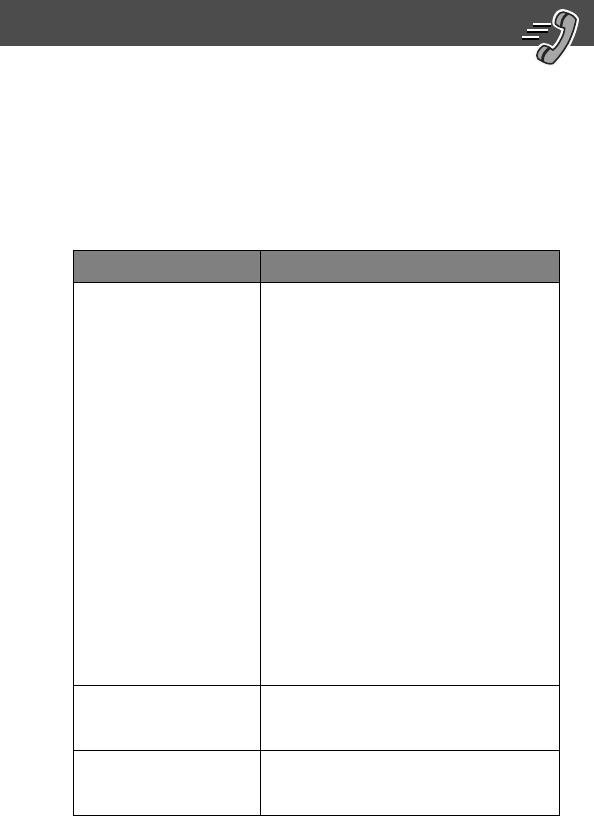
45
Sending and Receiving Calls
Additional Dialing Features
In addition to pressing numbers on your keypad, you
can insert numbers or characters and send calls in a
variety of ways.
While dialing (with digits visible in the display):
Do This To
Press M and
then scroll to and
select one of the
following:
•Insert Pause
(to insert a p)
•Insert Wait
(to insert a w)
•Insert 'n'
(to insert an n)
insert a special character when
making a calling card call:
• Pause tells your phone to
wait until the call connects
before it sends the next digit.
• Wait tells your phone to wait
until the call connects, and
then to prompt you before it
sends the next digit.
• 'n' tells your phone to stop
and to prompt you for a
number before it sends the
next digit.
Press M
> Attach Number
attach digits to precede the
phone number you are calling
Press M
> Send Message
create a text message addressed
to the number entered
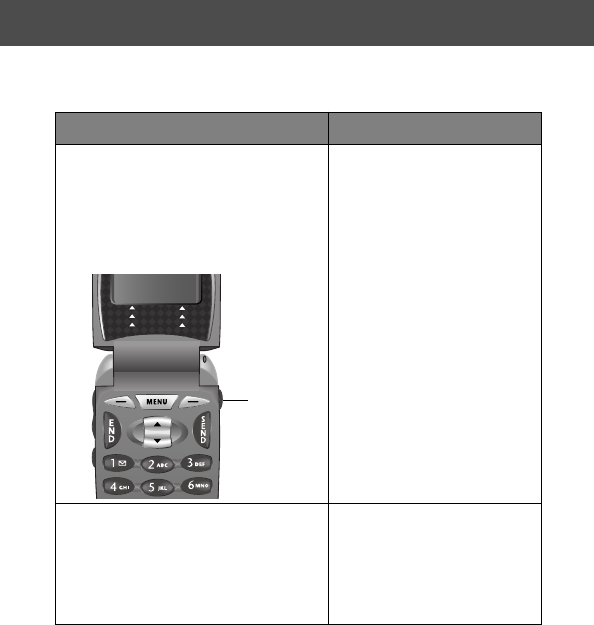
Sending and Receiving Calls
46
You can also call numbers using these features:
Do This To Call
Press and release the voice
key on the right side of your
phone and say the entry’s
name (in two seconds).
a phone number using
the voice dial feature
See “Recording a
Voice Name For a
Phonebook Entry” on
page 85.
Press M > Recent Calls
> Received Calls or
Dialed Calls >
entry to call
a missed call or a
number from a call
you recently dialed or
received
Voice
key
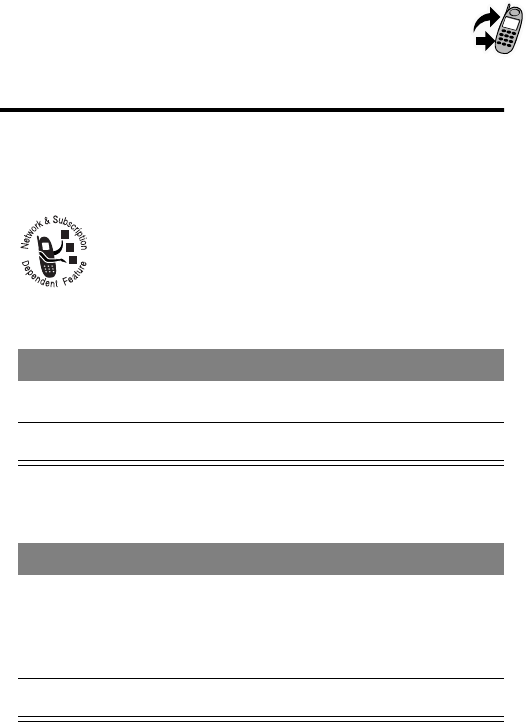
47
Using Features While On a
Call
Using Call Waiting
If you subscribe to call waiting, an alert tone
sounds while you are on a call to indicate that
you have received a second call.
To put the first call on hold and answer the second call:
To end the first call and answer the second call:
Press To
1
N answer the new call
2
N switch back to the first call
Press To
1
O end the current call
Your phone rings to signal the
new call.
2
N answer the new call
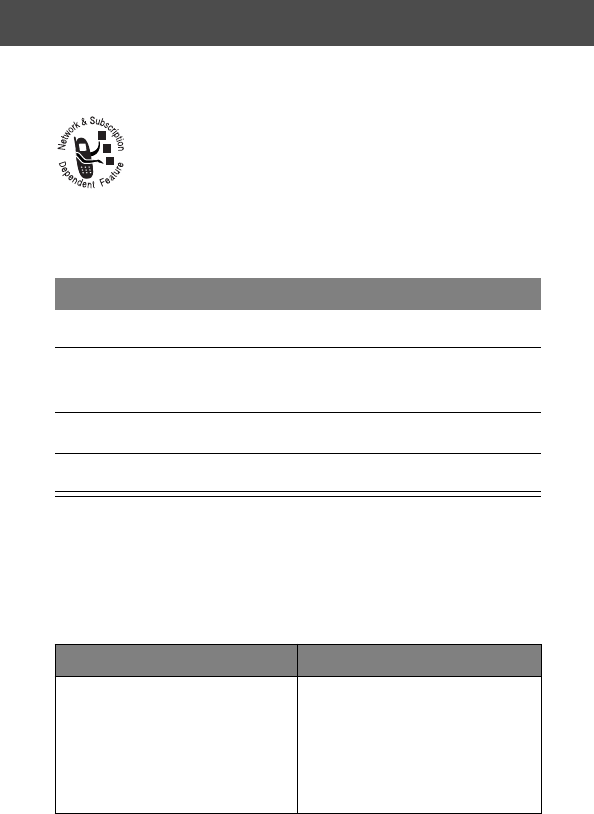
Using Features While On a Call
48
Making a Three-Way Call
During a call, you can call and connect a third
party so that the three of you can talk
together. You cannot do this if you already
have a call on hold.
During a call:
Additional On-Call Features
While you are on a call, you can perform the following
tasks:
Press To
1
keypad keys enter the third person’s number
2
N call the number and connect the
new person
3
N connect the two calls
4
O end the entire call
Do This To
Press MUTE (+)
(if available)
or
Press M > Mute
mute a call
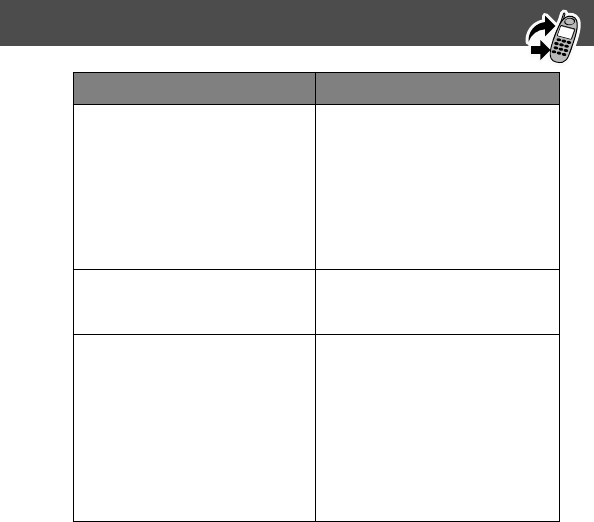
49
Using Features While On a Call
Press SPEAKER (+)
(if available)
or
Press M
> Spkrphone On
activate an attached
speakerphone
(hands-free mode)
Press M
> My Tel. Number
see your phone number
Press M > Send Tones send a number as DTMF
tones, for credit card
calling or password entry
To activate DTMF tones,
see the “DTMF” item on
page 67.
Do This To
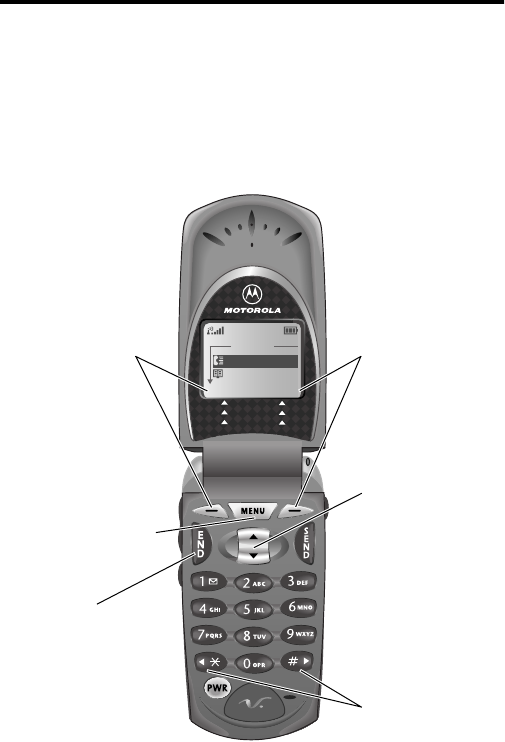
50
Using the Menu
Navigating to a Feature
You can access many of your phone’s features by using
these keys to move through the menu system:
Main Menu
)Recent Calls
)Phonebook
)EXIT)SELECT
Menu Key
Enter the menu
system or open a
sub-menu when
M
appears in the
bottom center of
the display.
Right Soft Key
Perform the
function shown
in the lower
right corner of
the display
(usually
SELECT
the highlighted
menu item).
Left Soft Key
Perform the
function shown
in the lower left
corner of the
display (usually
EXIT
or
BACK
).
Scroll Key
Move up or
down through
menus and lists.
* and #
Cycle through
and set the
value of the
highlighted
menu item.
End Key
Exit the menu
system without
making changes,
return to the idle
display.
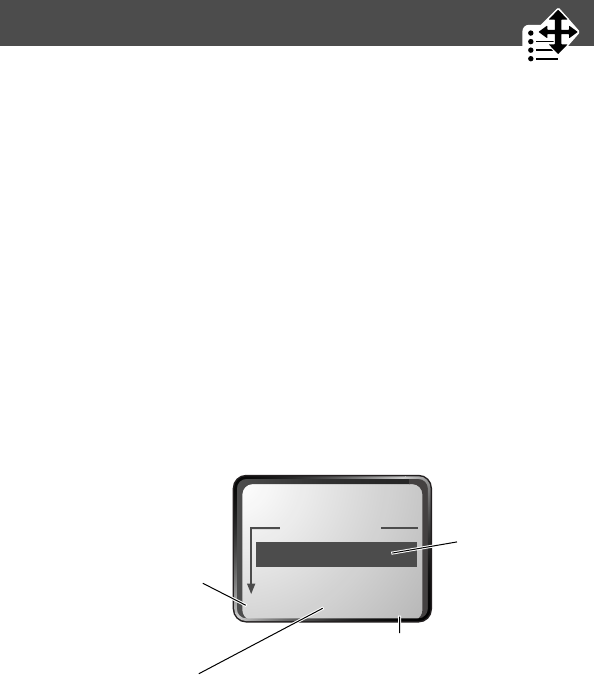
51
Using the Menu
This guide shows you how to navigate to a specific
menu feature as follows:
The > symbol means that you should scroll to and select
the feature. This example shows that you must press
M, scroll to and select Recent Calls, then scroll to
and select Dialed Calls to see the dialed calls list.
Selecting a Feature Option
Some features require you to select an item from a list:
Find the Feature
M> Recent Calls
> Dialed Calls
Dialed Calls
10) John Smith
9) Mary Smith
BACK VIEW
Press
BACK
(
-
) to
go back to the
previous screen.
A sub-menu is
available. Press
M
to open
the sub-menu.
Highlighted
item
Press
VIEW
(
+
) to view details
of the highlighted item.
STORE
(
+
) appears if you can
store the item in your phonebook.
M
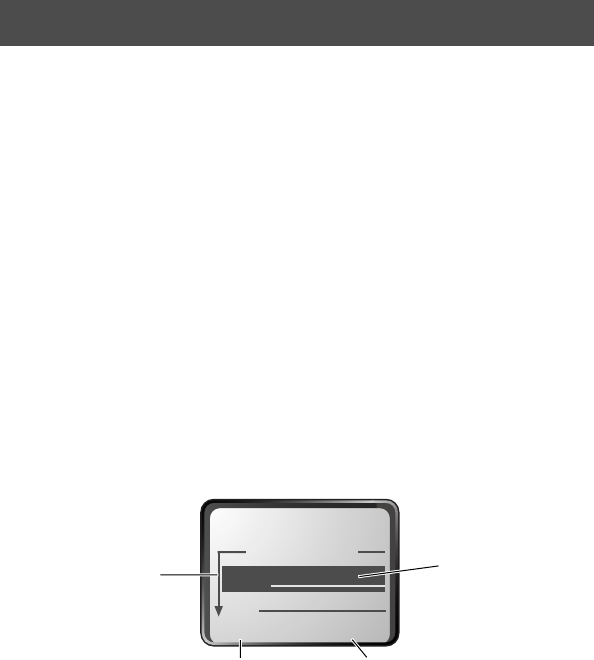
Using the Menu
52
Select an item by highlighting it. Use one of the
following approaches:
• Press S to scroll up or down to the item you want.
• In a numbered list, press a number key to highlight
the item.
• In an alphabetized list, press a key multiple times to
cycle through the letters on the key and highlight
the closest matching list item.
Entering Feature Information
Features such as the phonebook and datebook require
you to enter information to fill in an entry’s details:
Entry Details
Name:John Smith
No.:2125551212
CANCEL CHANGE
Press
S
to
scroll down
to additional
items.
Press
CANCEL
(
-
) to exit
without making changes.
DONE
(
-
) appears when you
enter or edit information. Press
DONE
(
-
) to save your changes.
Press
CHANGE
(
+
)
to edit the selected
information.
Highlighted
selection
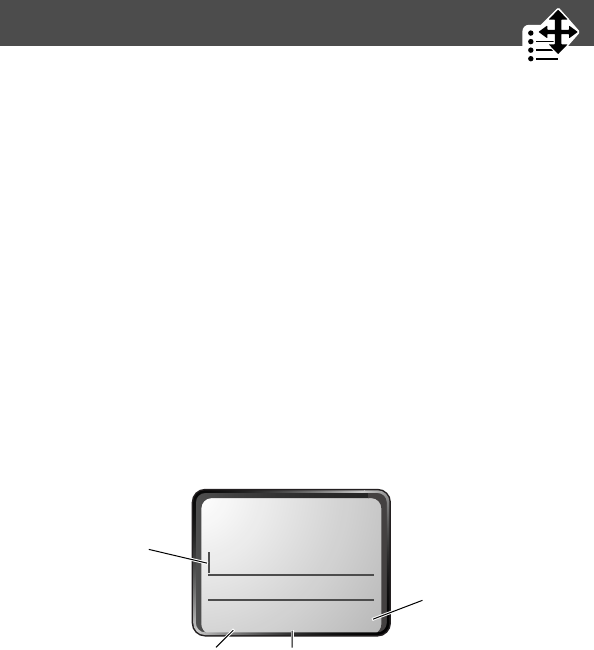
53
Using the Menu
• Enter numbers or text with the keypad. (See
“Entering Text” on page 54.)
• When an item has a list of possible values, press
* or # to scroll through and select a value.
• When an item has a list of possible numeric values,
press a number key to set the value.
• If you enter or edit information and then decide
that you do not want to save your changes, press O
to exit without saving.
The message center lets you compose and send text
messages. (See “Entering Text” on page 54.) A
flashing
cursor
shows you where the text will appear:
Msg:
CANCEL BROWSE
Press
BROWSE
(
+
)
to view and
insert a name,
number, or
message from
previously
stored
information.
Press
CANCEL
(
-
)
to exit without
making changes.
Flashing
cursor
indicates
insertion
point.
Press
M
to open the
sub-menu.
M
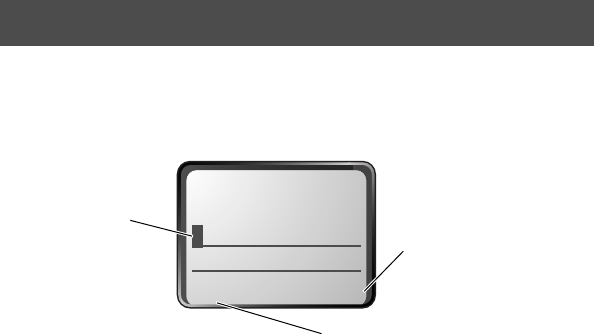
Using the Menu
54
When you enter text, the flashing cursor changes to a
block cursor
, and the soft key functions change:
Entering Text
General Text Entry Rules
Use the keypad to enter letters, numbers, and other
characters. Press the same key repeatedly to cycle
Msg:
T
DELETE OK
Press
OK
(
+
)
to accept and
store the text.
Press
DELETE
(
-
) to
delete the character to the
left of the insertion point.
Block
cursor
indicates
current
highlighted
character.
M
After two seconds, the
block cursor reverts to a
flashing cursor and moves
to the next position.